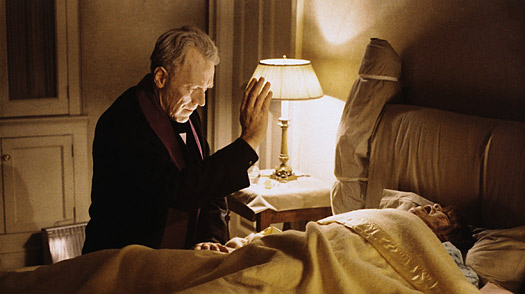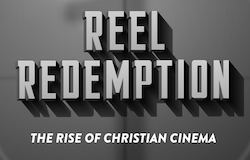On The Exorcist, by Reed Lackey
22 Oct
Let me put all my cards on the table. The Exorcist, the 1973 movie with all of that gushing pea soup, is my favorite movie of all time. But before you write me off as a demented lunatic or worse, I’d like the chance to tell you why that is. So please… sit down, try to relax. Grab a milkshake.
Again, I’m putting all my cards on the table. I know that the little girl says the f-word more than a few times. I know that she does perverse things to a crucifix in one scene. I know that she uses psychological abuse and outright projectile vomit to attack the priests who are trying to save her. In all of these scenes, she is under the full influence of the demon and I am as disturbed as any other sane person would be when I watch them.
I’m also aware that there was a lot of debate about whether or not the devil really loses in the end of the movie. Originally William Friedkin, who directed it, preferred an ending more subject to individual interpretation while William Peter Blatty, who wrote it, wanted a more definitive statement of evil’s defeat. I’ll sit with the writer on this one, though I do believe Friedkin might have been onto something.
The Exorcist is promoted and discussed primarily as a horror film, often called the scariest movie of all time. Thirty years ago, this was a completely appropriate characterization, but in today’s climate of films like Hostel, Paranormal Activity, and the Saw movies, The Exorcist doesn’t fully align with the genre conventions anymore. Maybe it never did. Its goal is not to make you jump. It isn’t trying to be cool or clever. And unlike most slasher films I’ve seen, you’re not rooting for the monster to claim its next victim in this one.
So, it’s a horror film in perhaps the purest sense: a film more interested in presenting you with a truly horrific scenario than it is with thrilling you or making you jump out of your seat. It’s uncomfortably realistic, not only in its special effects but also in the progression of events that build up to its climactic battle between good and evil. No other possession movie has ever struck this realism so effectively and precious few have even come close.
But OK –the film may be excellently made and technically very effective, but why on earth would I consider it my favorite movie of all time? Don’t get me wrong, I don’t fill my Saturday afternoons with relaxed viewings of The Exorcist while I’m in my pajamas. For that, I turn to reruns of The Simpsons or Macgyver or The Andy Griffith Show.
The Exorcist does one major thing right, though, which none of its copycat films have understood enough to duplicate (The Exorcism of Emily Rose came close, but still didn’t quite get there). In The Exorcist, the demon –as well as the poor girl it possesses—is incidental. They serve only as a catalyst for what the story’s really about. And it’s the theme at the heart of The Exorcist which makes it my favorite.
There are three major players around whom the theme of The Exorcist revolves. First, we have the little girl’s mother, Chris MacNeil. She is a loving mother, a successful career woman, and a confirmed skeptic. When this tragedy strikes her family, she shifts through various stages of doubt and desperation, but always cares exclusively for the well-being of her daughter.
Next, we have Father Karras, a sincere man of the cloth who finds himself struggling with his faith in light of personal failures and the death of his mother (which he carries as his own fault). Quite suddenly he finds himself as the only hope a desperate mother has for the life of her child.
Finally, we have the hero of the film’s title—Father Merrin, the Exorcist. Father Merrin is very old and his health is failing, but his faith is still firm and when Karras reaches out for someone with experience in the realm of demonic possession, Merrin is called in to help.
Each of these three characters shows us a different way to approach the problem of evil and sudden inexplicable tragedy. Many, like the mother, wander through the situation in desperate need, unable to control or influence any of what’s happening beyond crying out for help. Others, like the older priest, seem assured and steadfast both in their perspective on the circumstance and in their resolve for how to address the needs. But where I find myself, perhaps where most of us will find ourselves, is in the shoes of the young Father Karras.
Karras’s struggle is one many are familiar with. He is a good-hearted, sincere man who puts great effort and intention behind living and working for the benefit of others. Yet, his faith is struggling. He is confused by the uncertainty in the world around him and longs for some sign or evidence that all of his efforts have not been in vain (cue the “careful-what-you-wish-for” buttons here).
Some of the issues that people have with the film are theological ones. I have often heard objections to the fact that the demon does not immediately vacate the little girl at the name of Jesus, or to the fact that when the demon does leave, he seems to leave because of a better offer rather than being genuinely defeated. Is the film saying that the only power we have over evil is the ability to bargain with it? I’m sympathetic to these concerns because they arise in me almost daily.
Those same concerns arise when I hear of a movie theater showing The Dark Knight Rises at midnight where a man ambushes the audience with automatic gunfire. Those same concerns arise when I hear about good and faithful believers suddenly struck with devastating and potentially fatal illnesses. Those same concerns arise when I hear about a young couple who lost their nine month old son to SIDS. There are no easy answers for these things and despite my firm belief in the power of Jesus Christ, sometimes suffering doesn’t budge.
And to such tragedies, there is any of a countless number of responses. The most effective are the silent ones which simply provide the presence of a steady shoulder to lean on or a warm hand to hold. The cruelest responses are the clichéd attempts at sound-bite comfort, which are awkward and unhelpful at best and overtly offensive at worst. I once heard a comforter say to a grieving mother of an infant son, “Somehow God will use this to bring Himself glory,” which was both an offensive dismissal of the mother’s pain and a misguided attempt to defend the one many were silently blaming. Perhaps the comforter’s heart was in the right place, but I can’t be sure.
There is a moment in the novel of The Exorcist that was filmed for the movie, but not added in until the extended edition was released. The moment involves a break in the ordeal of the exorcism when the older priest (Father Merrin) and the younger priest (Father Karras) slump down at the top of the stairs to catch their breath. Karras looks at Merrin, who seems so assured and confident in his understanding of the conflict they are in, and asks, “Why here? Why this little girl?” The situations may change, but that really is the question, isn’t it?
Merrin’s answer to this question comes from a heart that is weary to the point of breaking, yet full of faith. Merrin said, “I think the point is to make us despair. To see ourselves as… animal and ugly. To make us reject the possibility that God could love us.”
I have despaired before. I have seen myself as ugly and unwanted. I have believed there was no way God could love me and I have validated those fears with evidence of the suffering and inexplicable tragedy in my life and the world around me. I know that kind of despair.
Father Merrin’s heart eventually gives out, as old hearts sometimes do, and he does not survive the exorcism. What we would want at that moment is for the young priest to step in, speak with boldness and authority and drive the demon out of the girl. What happens instead is that he wrestles the demon to the ground and, with a cry of desperate rage, offers himself up in the little girl’s place. When the demon enters him, Karras throws himself out the third floor window onto the steps below, ending his life and the demon’s hold on this family. He broke the darkness by laying down his life.
I would prefer that evil could be vanquished with a word as well. Jesus certainly did that multiple times in the Bible. But ultimately, there was one victory in which Jesus barely opened his mouth. Rather than dispel the darkness with a word of authority, Jesus offered himself up and let the darkness claim him at the cross instead. Again, the darkness was broken.
I love The Exorcist. I don’t enjoy every scene and it’s not a movie I would watch to relax. But it is my favorite movie because I have never seen a film be so unflinching in its depiction of evil at work, yet so honest in its portrayal of the humanity that defeats it. There are no safe answers in the questions of evil. There are no bumper sticker catchphrases or clever solutions to the agony of suffering. Instead, we have the courage of fragile hearts and the faith of struggling sinners reaching out for grace. And there is also love. “Greater love has no man than this: that a man lay down his life for his friends.” Perhaps the greatest mystery of evil is not its power to make us despair, but its weakness in the face of self-sacrifice.




No comments yet